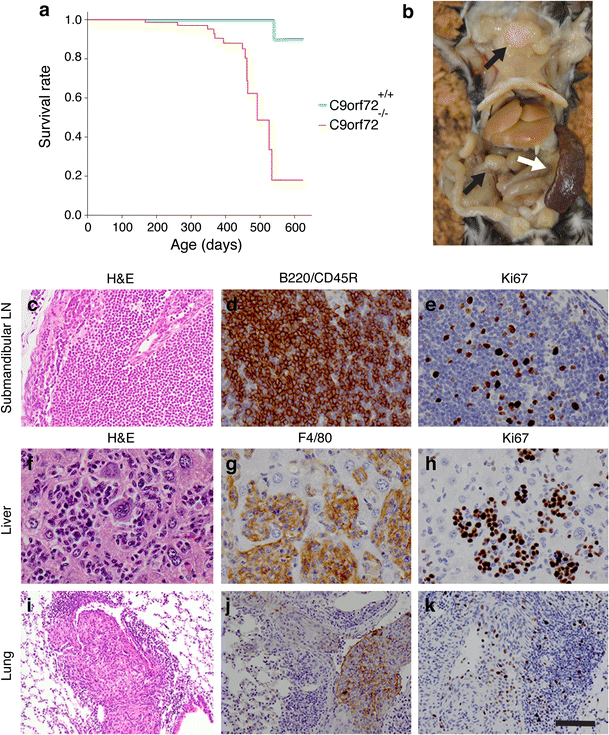Avoid common mistakes on your manuscript.
Non-coding hexanucleotide (GGGGCC) repeat expansions in C9ORF72 are the most common genetic cause of amyotrophic lateral sclerosis (ALS) and frontotemporal dementia (FTD; C9ALS/FTD). Decreased C9orf72 protein levels in C9ALS/FTD patients [4] support the idea that C9ORF72 haploinsufficiency may contribute to disease pathogenesis. To test this hypothesis, we previously generated and analyzed neural-specific C9orf72 knockout mice. Our results showed that neural-specific ablation of C9orf72 (3110043O21Rik) in mice does not cause motor neuron degeneration or changes in motor function [3]. We therefore concluded that loss of C9ORF72 on its own is unlikely to cause ALS and that reducing C9ORF72 levels may comprise a promising strategy to treat C9-ALS patients. This therapeutic potential led us, and others [1, 2], to subsequently analyze knockout mice lacking C9orf72 in all tissues. Importantly, in contrast to our previous report, we find that full ablation of C9orf72 induces reduced survival (Fig. 1a), which is in line with a recent study by Atanasio et al. [1] who report, but do not specify, decreased survival rates. In line with our previous observations [3], full C9orf72 ablation results in a 5.9 % decrease in body weight (P = 0.0056), without affecting motor function (accelerating rotarod and grip strength test) or inducing pathological hallmarks of ALS (see also [1, 2]), such as motor neuron degeneration, gliosis, enhanced ubiquitination and TDP-43 mislocalization. However, post-mortem analysis of full C9orf72 knockout mice (n = 5; 11–15 months of age) revealed enlarged lymph nodes (LNs) (n = 4 mice) and splenomegaly (n = 5) (Fig. 1b). Detailed histological evaluation detected massive infiltration of histiocytes/macrophages and lymphocytes in multiple organs, including LNs, spleen, bone marrow, liver, kidney and lung (Fig. 1c–k). In addition to these immunological phenotypes, which are in part also reported by Atanasio et al. [1] and O’Rourke et al. [2], we detect evidence of neoplastic events. LNs of several animals (n = 4) contained infiltrates of B220/CD45R-positive B-lymphocytes that disrupted tissue architecture and were accompanied by increased expression of the proliferation marker Ki67, suggesting the development of B-cell lymphomas (Fig. 1c–e). Furthermore, disrupted tissue architecture and homogeneous populations of F4/80-positive macrophages expressing Ki67 were present in LNs (n = 3), spleen (n = 3), liver (n = 1) and lung (n = 1). Moreover, infiltrating cells in the liver and lung accumulated in intravascular spaces (Fig. 1f–k), suggesting the occurrence of metastatic histiocytic sarcomas. These results indicate that the defects in immune cell function recently reported in C9orf72 knockout mice (e.g. changes in endosome/lysosomal trafficking, cytokine production) [1, 2] may ultimately lead to neoplastic events in multiple organs. These findings have important implications as they indicate that strategies aimed at lowering systemic C9ORF72 levels in C9ALS/FTD patients may have negative side effects and that emphasis should be on therapeutic approaches that selectively target the hexanucleotide repeat expansions or their downstream pathogenic effects.
C9orf72 knockout mice display reduced survival, immune system-related pathology and neoplastic events. a Kaplan–Meier curves show survival rates corrected for gender and body weight. C9orf72 knockout mice show reduced survival as compared to littermate controls (Hazard ratio = 19.0; 95 %, CI: 2.4–150.2, P = 0.005). Wild-type controls n = 24; C9orf72 knockout n = 29. b Gross image showing enlarged lymph nodes (LNs; black arrows) and splenomegaly (white arrow) in a C9orf72 knockout mouse (12 months of age). c–e B-cell lymphoma in the submandibular LNs of C9orf72 knockout mouse. Nodal tissue is effaced by a monotypic cell population composed of B220/CD45R-positive lymphocytes (B cells). Note the high proliferation rate of the neoplastic lymphocytes as indicated by immunostaining for Ki67 (proliferation marker). f–h Histiocytic sarcoma in the liver of C9orf72 knockout mouse. Hepatic sinusoids are filled with atypical histiocytes and multinucleated giant cells that stain positive for the macrophage lineage marker F4/80 and exhibit a high proliferation rate, as evidenced by Ki67 immunostaining. i–k Histiocytic sarcoma in lung vasculature in C9orf72 knockout mouse. Pulmonary blood vessels are filled with atypical and multinucleated giant cells that immunostain for F4/80 and Ki67. H&E hematoxylin and eosin. Scale bar 1.3 cm (b), 65 μm (c), 40 μm (d–h), 125 μm (i), and 90 μm (j, k)
References
Atanasio A, Decman V, White D et al (2016) C9orf72 ablation causes immune dysregulation characterized by leukocyte expansion, autoantibody production, and glomerulonephropathy in mice. Sci Rep 6:23204. doi:10.1038/srep23204
O’Rourke JG, Bogdanik L, Yáñez A et al (2016) C9orf72 is required for proper macrophage and microglial function in mice. Science 351:1324–1329. doi:10.1126/science.aaf1064
Koppers M, Blokhuis AM, Westeneng HJ et al (2015) C9orf72 ablation in mice does not cause motor neuron degeneration or motor deficits. Ann Neurol 78:426–438. doi:10.1002/ana.24453
Waite AJ, Baumer D, East S et al (2014) Reduced C9orf72 protein levels in frontal cortex of amyotrophic lateral sclerosis and frontotemporal degeneration brain with the C9ORF72 hexanucleotide repeat expansion. Neurobiol Aging 35:1779.e5–1779.e13. doi:10.1016/j.neurobiolaging.2014.01.016
Acknowledgments
This study was supported by funding from the Netherlands Organization for Health Research and Development (NWO-VICI; LvdB and RJP); Thierry Latran Foundation (JHV and RJP), Prinses Beatrix Spierfonds (LvdB and RJP), Van Meer Stichting, and Netherlands ALS foundation (TOTALS; LvdB and RJP).
Author information
Authors and Affiliations
Corresponding author
Ethics declarations
Conflict of interest
The authors declare no conflicts of interest.
Additional information
L. H. van den Berg and R. J. Pasterkamp are joint senior authors.
Rights and permissions
Open Access This article is distributed under the terms of the Creative Commons Attribution 4.0 International License (http://creativecommons.org/licenses/by/4.0/), which permits unrestricted use, distribution, and reproduction in any medium, provided you give appropriate credit to the original author(s) and the source, provide a link to the Creative Commons license, and indicate if changes were made.
About this article
Cite this article
Sudria-Lopez, E., Koppers, M., de Wit, M. et al. Full ablation of C9orf72 in mice causes immune system-related pathology and neoplastic events but no motor neuron defects. Acta Neuropathol 132, 145–147 (2016). https://doi.org/10.1007/s00401-016-1581-x
Received:
Revised:
Accepted:
Published:
Issue Date:
DOI: https://doi.org/10.1007/s00401-016-1581-x


